Business and Law Essay
VerifiedAdded on 2020/10/22
|14
|5459
|243
AI Summary
This assignment delves into the complexities of business and law, covering a range of topics including corporate governance, ethics, and regulations. It draws on various sources, including academic journals, books, and online resources, to provide a nuanced understanding of the subject matter.
Contribute Materials
Your contribution can guide someone’s learning journey. Share your
documents today.
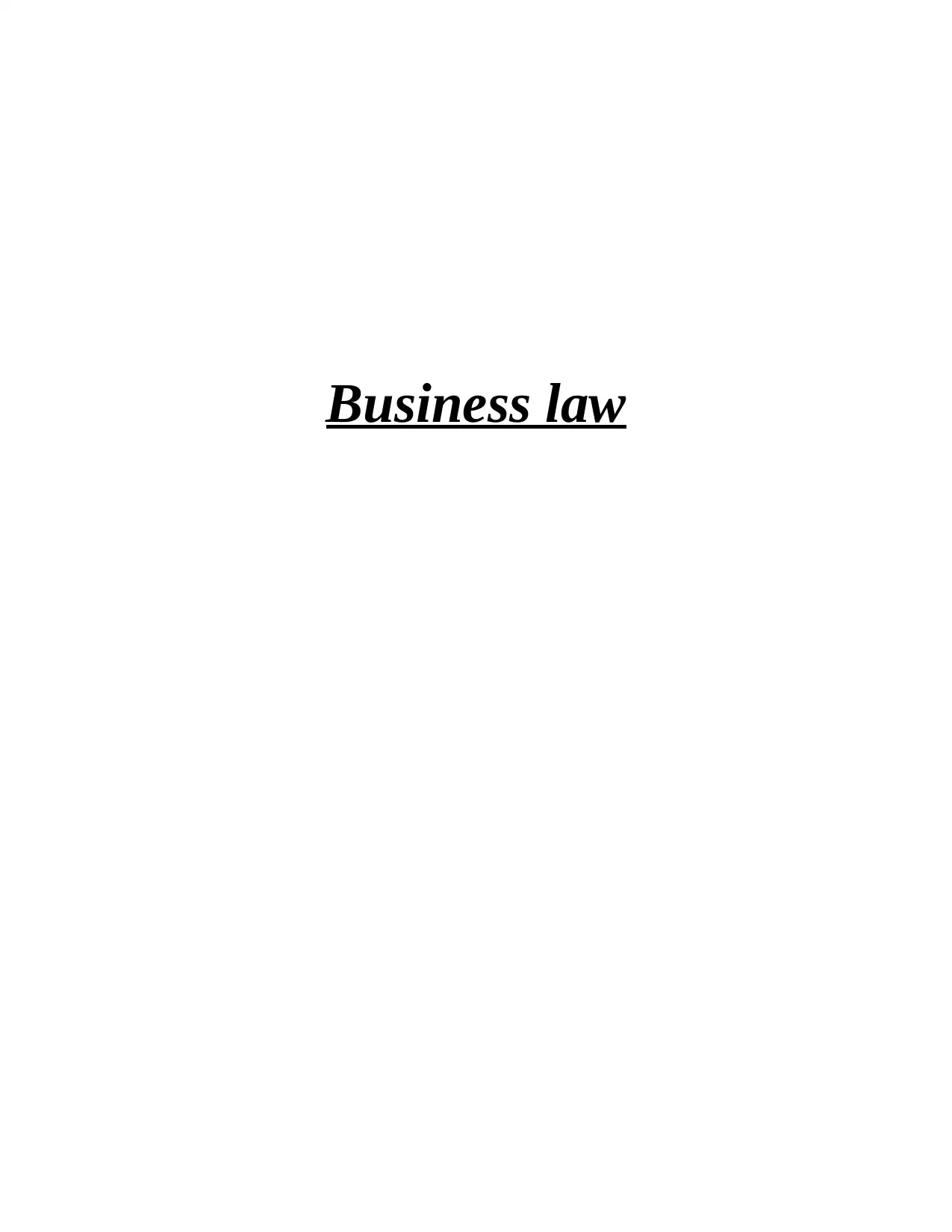
Business law
Secure Best Marks with AI Grader
Need help grading? Try our AI Grader for instant feedback on your assignments.
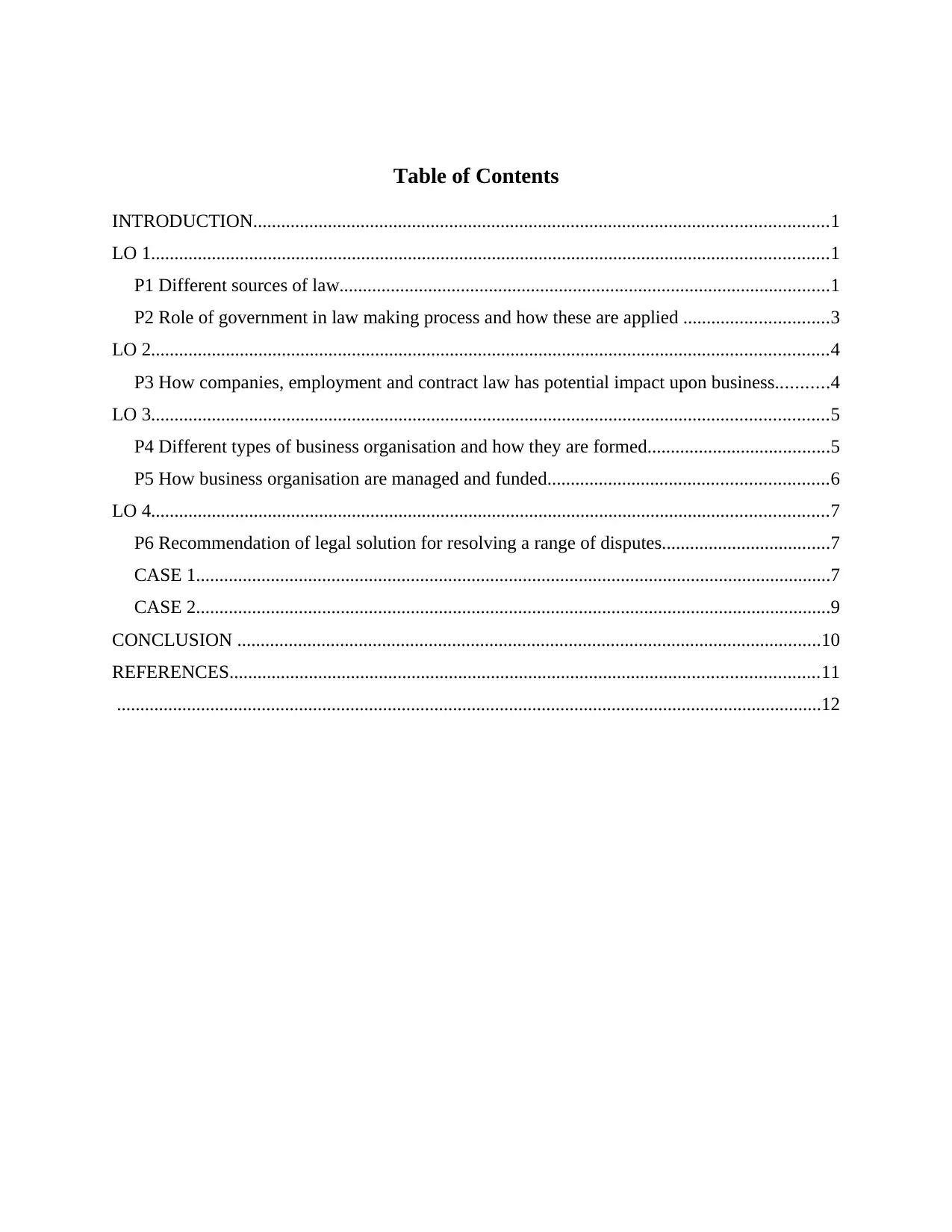
Table of Contents
INTRODUCTION...........................................................................................................................1
LO 1.................................................................................................................................................1
P1 Different sources of law.........................................................................................................1
P2 Role of government in law making process and how these are applied ...............................3
LO 2.................................................................................................................................................4
P3 How companies, employment and contract law has potential impact upon business...........4
LO 3.................................................................................................................................................5
P4 Different types of business organisation and how they are formed.......................................5
P5 How business organisation are managed and funded............................................................6
LO 4.................................................................................................................................................7
P6 Recommendation of legal solution for resolving a range of disputes....................................7
CASE 1........................................................................................................................................7
CASE 2........................................................................................................................................9
CONCLUSION .............................................................................................................................10
REFERENCES..............................................................................................................................11
.......................................................................................................................................................12
INTRODUCTION...........................................................................................................................1
LO 1.................................................................................................................................................1
P1 Different sources of law.........................................................................................................1
P2 Role of government in law making process and how these are applied ...............................3
LO 2.................................................................................................................................................4
P3 How companies, employment and contract law has potential impact upon business...........4
LO 3.................................................................................................................................................5
P4 Different types of business organisation and how they are formed.......................................5
P5 How business organisation are managed and funded............................................................6
LO 4.................................................................................................................................................7
P6 Recommendation of legal solution for resolving a range of disputes....................................7
CASE 1........................................................................................................................................7
CASE 2........................................................................................................................................9
CONCLUSION .............................................................................................................................10
REFERENCES..............................................................................................................................11
.......................................................................................................................................................12
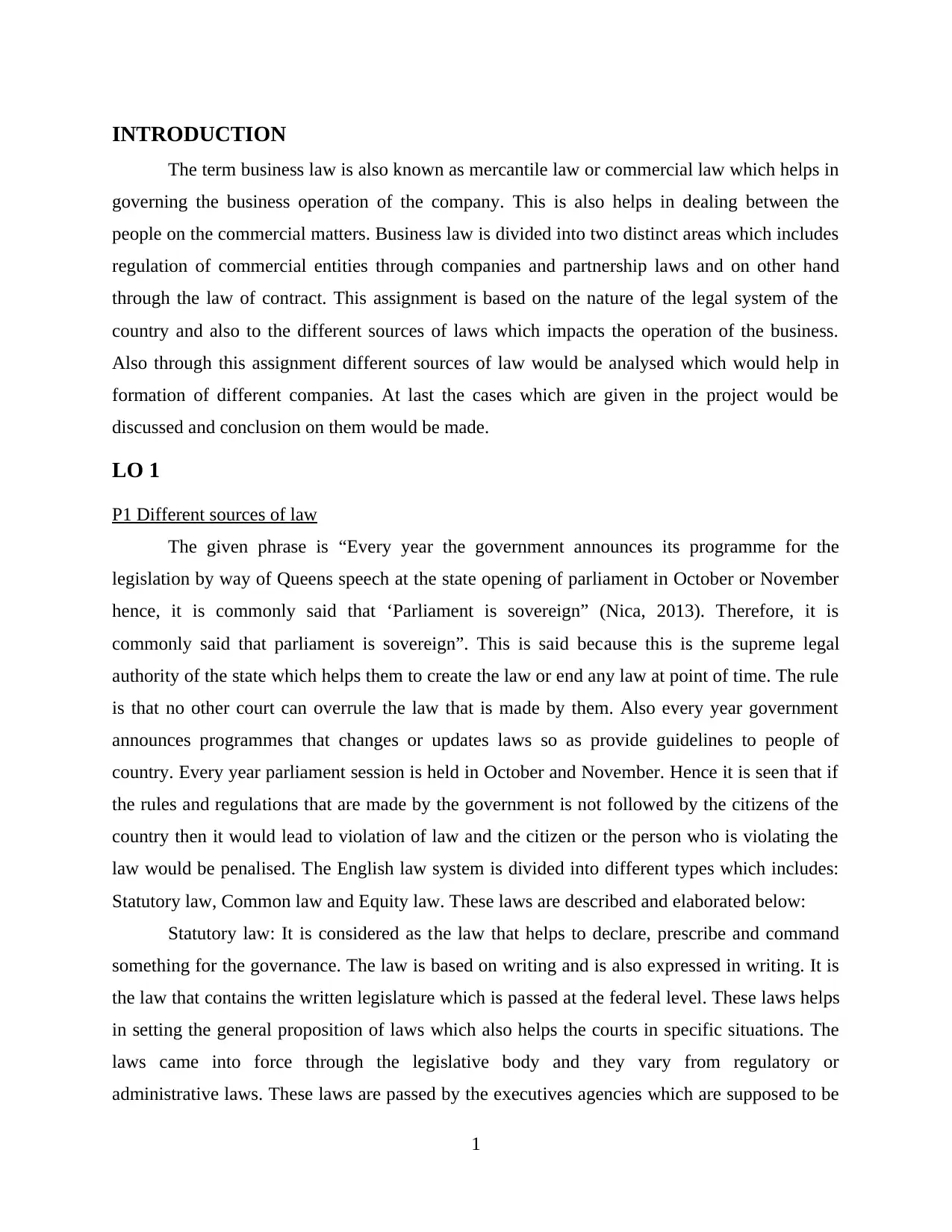
INTRODUCTION
The term business law is also known as mercantile law or commercial law which helps in
governing the business operation of the company. This is also helps in dealing between the
people on the commercial matters. Business law is divided into two distinct areas which includes
regulation of commercial entities through companies and partnership laws and on other hand
through the law of contract. This assignment is based on the nature of the legal system of the
country and also to the different sources of laws which impacts the operation of the business.
Also through this assignment different sources of law would be analysed which would help in
formation of different companies. At last the cases which are given in the project would be
discussed and conclusion on them would be made.
LO 1
P1 Different sources of law
The given phrase is “Every year the government announces its programme for the
legislation by way of Queens speech at the state opening of parliament in October or November
hence, it is commonly said that ‘Parliament is sovereign” (Nica, 2013). Therefore, it is
commonly said that parliament is sovereign”. This is said because this is the supreme legal
authority of the state which helps them to create the law or end any law at point of time. The rule
is that no other court can overrule the law that is made by them. Also every year government
announces programmes that changes or updates laws so as provide guidelines to people of
country. Every year parliament session is held in October and November. Hence it is seen that if
the rules and regulations that are made by the government is not followed by the citizens of the
country then it would lead to violation of law and the citizen or the person who is violating the
law would be penalised. The English law system is divided into different types which includes:
Statutory law, Common law and Equity law. These laws are described and elaborated below:
Statutory law: It is considered as the law that helps to declare, prescribe and command
something for the governance. The law is based on writing and is also expressed in writing. It is
the law that contains the written legislature which is passed at the federal level. These laws helps
in setting the general proposition of laws which also helps the courts in specific situations. The
laws came into force through the legislative body and they vary from regulatory or
administrative laws. These laws are passed by the executives agencies which are supposed to be
1
The term business law is also known as mercantile law or commercial law which helps in
governing the business operation of the company. This is also helps in dealing between the
people on the commercial matters. Business law is divided into two distinct areas which includes
regulation of commercial entities through companies and partnership laws and on other hand
through the law of contract. This assignment is based on the nature of the legal system of the
country and also to the different sources of laws which impacts the operation of the business.
Also through this assignment different sources of law would be analysed which would help in
formation of different companies. At last the cases which are given in the project would be
discussed and conclusion on them would be made.
LO 1
P1 Different sources of law
The given phrase is “Every year the government announces its programme for the
legislation by way of Queens speech at the state opening of parliament in October or November
hence, it is commonly said that ‘Parliament is sovereign” (Nica, 2013). Therefore, it is
commonly said that parliament is sovereign”. This is said because this is the supreme legal
authority of the state which helps them to create the law or end any law at point of time. The rule
is that no other court can overrule the law that is made by them. Also every year government
announces programmes that changes or updates laws so as provide guidelines to people of
country. Every year parliament session is held in October and November. Hence it is seen that if
the rules and regulations that are made by the government is not followed by the citizens of the
country then it would lead to violation of law and the citizen or the person who is violating the
law would be penalised. The English law system is divided into different types which includes:
Statutory law, Common law and Equity law. These laws are described and elaborated below:
Statutory law: It is considered as the law that helps to declare, prescribe and command
something for the governance. The law is based on writing and is also expressed in writing. It is
the law that contains the written legislature which is passed at the federal level. These laws helps
in setting the general proposition of laws which also helps the courts in specific situations. The
laws came into force through the legislative body and they vary from regulatory or
administrative laws. These laws are passed by the executives agencies which are supposed to be
1
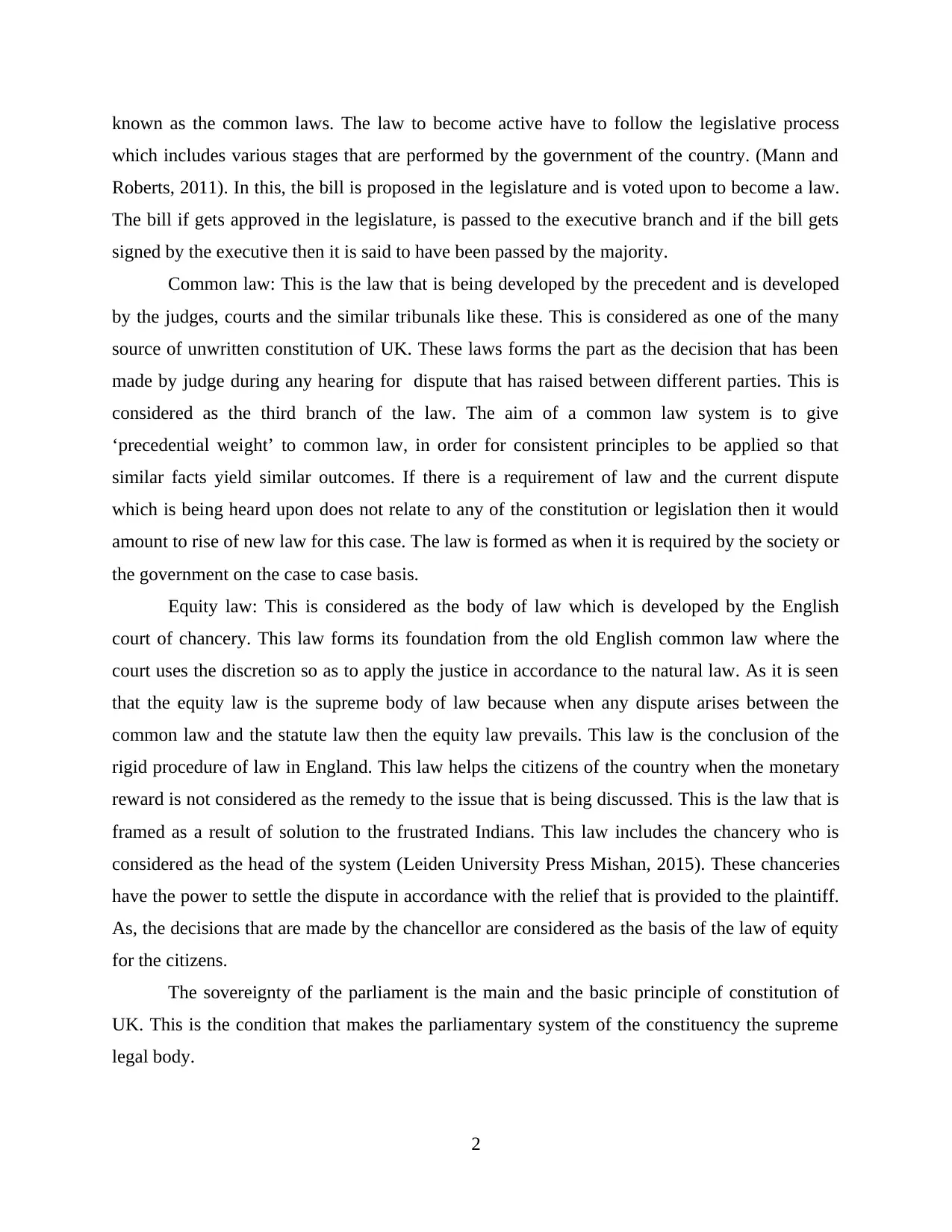
known as the common laws. The law to become active have to follow the legislative process
which includes various stages that are performed by the government of the country. (Mann and
Roberts, 2011). In this, the bill is proposed in the legislature and is voted upon to become a law.
The bill if gets approved in the legislature, is passed to the executive branch and if the bill gets
signed by the executive then it is said to have been passed by the majority.
Common law: This is the law that is being developed by the precedent and is developed
by the judges, courts and the similar tribunals like these. This is considered as one of the many
source of unwritten constitution of UK. These laws forms the part as the decision that has been
made by judge during any hearing for dispute that has raised between different parties. This is
considered as the third branch of the law. The aim of a common law system is to give
‘precedential weight’ to common law, in order for consistent principles to be applied so that
similar facts yield similar outcomes. If there is a requirement of law and the current dispute
which is being heard upon does not relate to any of the constitution or legislation then it would
amount to rise of new law for this case. The law is formed as when it is required by the society or
the government on the case to case basis.
Equity law: This is considered as the body of law which is developed by the English
court of chancery. This law forms its foundation from the old English common law where the
court uses the discretion so as to apply the justice in accordance to the natural law. As it is seen
that the equity law is the supreme body of law because when any dispute arises between the
common law and the statute law then the equity law prevails. This law is the conclusion of the
rigid procedure of law in England. This law helps the citizens of the country when the monetary
reward is not considered as the remedy to the issue that is being discussed. This is the law that is
framed as a result of solution to the frustrated Indians. This law includes the chancery who is
considered as the head of the system (Leiden University Press Mishan, 2015). These chanceries
have the power to settle the dispute in accordance with the relief that is provided to the plaintiff.
As, the decisions that are made by the chancellor are considered as the basis of the law of equity
for the citizens.
The sovereignty of the parliament is the main and the basic principle of constitution of
UK. This is the condition that makes the parliamentary system of the constituency the supreme
legal body.
2
which includes various stages that are performed by the government of the country. (Mann and
Roberts, 2011). In this, the bill is proposed in the legislature and is voted upon to become a law.
The bill if gets approved in the legislature, is passed to the executive branch and if the bill gets
signed by the executive then it is said to have been passed by the majority.
Common law: This is the law that is being developed by the precedent and is developed
by the judges, courts and the similar tribunals like these. This is considered as one of the many
source of unwritten constitution of UK. These laws forms the part as the decision that has been
made by judge during any hearing for dispute that has raised between different parties. This is
considered as the third branch of the law. The aim of a common law system is to give
‘precedential weight’ to common law, in order for consistent principles to be applied so that
similar facts yield similar outcomes. If there is a requirement of law and the current dispute
which is being heard upon does not relate to any of the constitution or legislation then it would
amount to rise of new law for this case. The law is formed as when it is required by the society or
the government on the case to case basis.
Equity law: This is considered as the body of law which is developed by the English
court of chancery. This law forms its foundation from the old English common law where the
court uses the discretion so as to apply the justice in accordance to the natural law. As it is seen
that the equity law is the supreme body of law because when any dispute arises between the
common law and the statute law then the equity law prevails. This law is the conclusion of the
rigid procedure of law in England. This law helps the citizens of the country when the monetary
reward is not considered as the remedy to the issue that is being discussed. This is the law that is
framed as a result of solution to the frustrated Indians. This law includes the chancery who is
considered as the head of the system (Leiden University Press Mishan, 2015). These chanceries
have the power to settle the dispute in accordance with the relief that is provided to the plaintiff.
As, the decisions that are made by the chancellor are considered as the basis of the law of equity
for the citizens.
The sovereignty of the parliament is the main and the basic principle of constitution of
UK. This is the condition that makes the parliamentary system of the constituency the supreme
legal body.
2
Secure Best Marks with AI Grader
Need help grading? Try our AI Grader for instant feedback on your assignments.
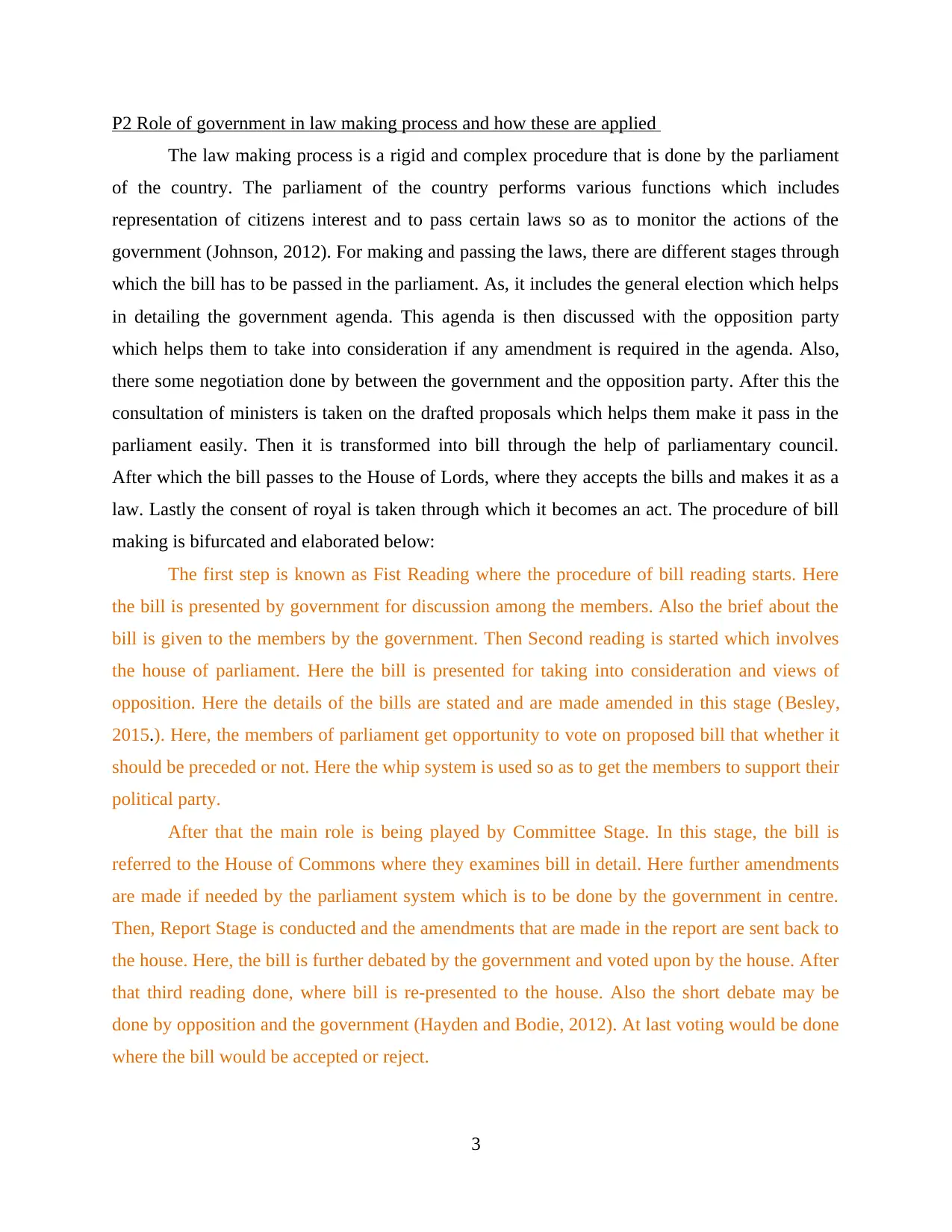
P2 Role of government in law making process and how these are applied
The law making process is a rigid and complex procedure that is done by the parliament
of the country. The parliament of the country performs various functions which includes
representation of citizens interest and to pass certain laws so as to monitor the actions of the
government (Johnson, 2012). For making and passing the laws, there are different stages through
which the bill has to be passed in the parliament. As, it includes the general election which helps
in detailing the government agenda. This agenda is then discussed with the opposition party
which helps them to take into consideration if any amendment is required in the agenda. Also,
there some negotiation done by between the government and the opposition party. After this the
consultation of ministers is taken on the drafted proposals which helps them make it pass in the
parliament easily. Then it is transformed into bill through the help of parliamentary council.
After which the bill passes to the House of Lords, where they accepts the bills and makes it as a
law. Lastly the consent of royal is taken through which it becomes an act. The procedure of bill
making is bifurcated and elaborated below:
The first step is known as Fist Reading where the procedure of bill reading starts. Here
the bill is presented by government for discussion among the members. Also the brief about the
bill is given to the members by the government. Then Second reading is started which involves
the house of parliament. Here the bill is presented for taking into consideration and views of
opposition. Here the details of the bills are stated and are made amended in this stage (Besley,
2015.). Here, the members of parliament get opportunity to vote on proposed bill that whether it
should be preceded or not. Here the whip system is used so as to get the members to support their
political party.
After that the main role is being played by Committee Stage. In this stage, the bill is
referred to the House of Commons where they examines bill in detail. Here further amendments
are made if needed by the parliament system which is to be done by the government in centre.
Then, Report Stage is conducted and the amendments that are made in the report are sent back to
the house. Here, the bill is further debated by the government and voted upon by the house. After
that third reading done, where bill is re-presented to the house. Also the short debate may be
done by opposition and the government (Hayden and Bodie, 2012). At last voting would be done
where the bill would be accepted or reject.
3
The law making process is a rigid and complex procedure that is done by the parliament
of the country. The parliament of the country performs various functions which includes
representation of citizens interest and to pass certain laws so as to monitor the actions of the
government (Johnson, 2012). For making and passing the laws, there are different stages through
which the bill has to be passed in the parliament. As, it includes the general election which helps
in detailing the government agenda. This agenda is then discussed with the opposition party
which helps them to take into consideration if any amendment is required in the agenda. Also,
there some negotiation done by between the government and the opposition party. After this the
consultation of ministers is taken on the drafted proposals which helps them make it pass in the
parliament easily. Then it is transformed into bill through the help of parliamentary council.
After which the bill passes to the House of Lords, where they accepts the bills and makes it as a
law. Lastly the consent of royal is taken through which it becomes an act. The procedure of bill
making is bifurcated and elaborated below:
The first step is known as Fist Reading where the procedure of bill reading starts. Here
the bill is presented by government for discussion among the members. Also the brief about the
bill is given to the members by the government. Then Second reading is started which involves
the house of parliament. Here the bill is presented for taking into consideration and views of
opposition. Here the details of the bills are stated and are made amended in this stage (Besley,
2015.). Here, the members of parliament get opportunity to vote on proposed bill that whether it
should be preceded or not. Here the whip system is used so as to get the members to support their
political party.
After that the main role is being played by Committee Stage. In this stage, the bill is
referred to the House of Commons where they examines bill in detail. Here further amendments
are made if needed by the parliament system which is to be done by the government in centre.
Then, Report Stage is conducted and the amendments that are made in the report are sent back to
the house. Here, the bill is further debated by the government and voted upon by the house. After
that third reading done, where bill is re-presented to the house. Also the short debate may be
done by opposition and the government (Hayden and Bodie, 2012). At last voting would be done
where the bill would be accepted or reject.
3
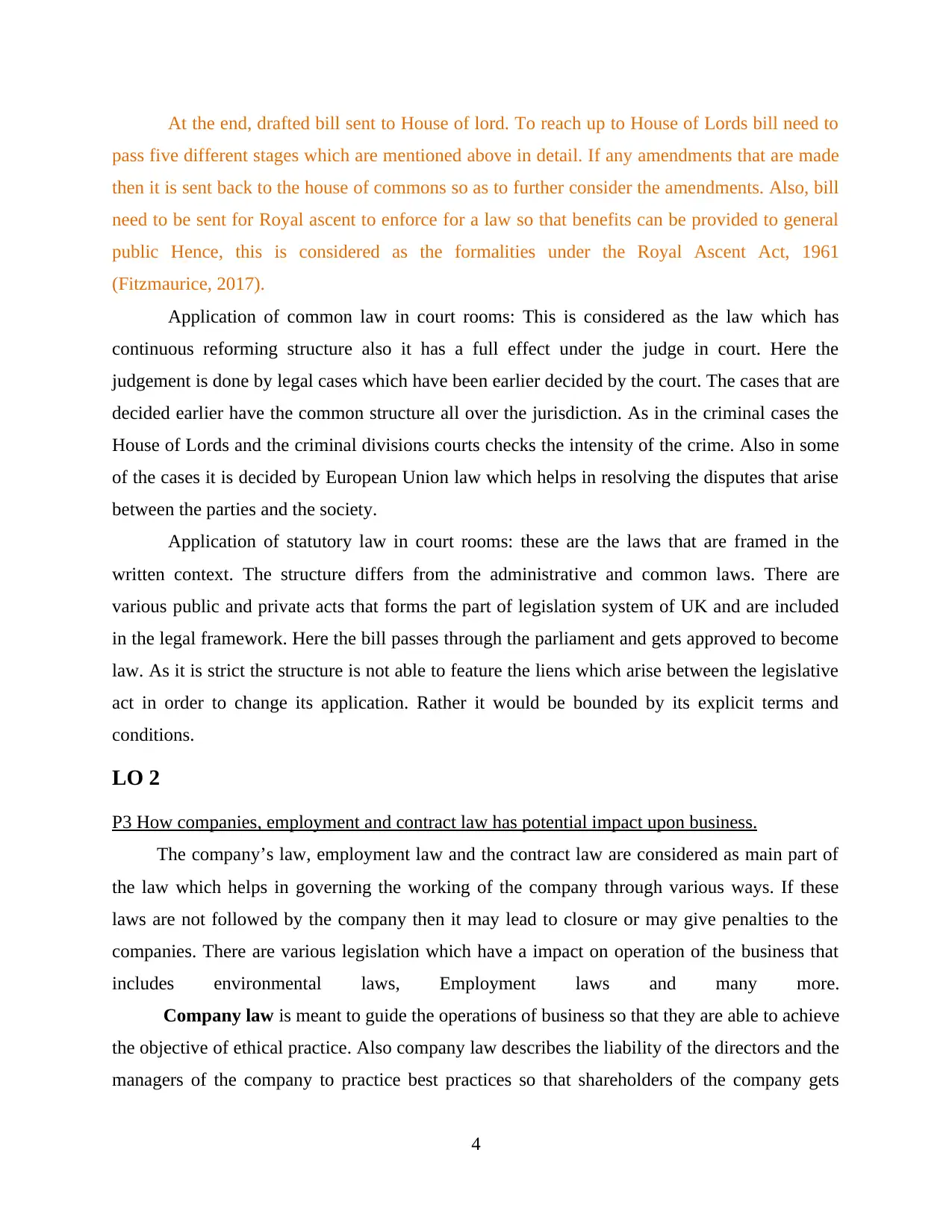
At the end, drafted bill sent to House of lord. To reach up to House of Lords bill need to
pass five different stages which are mentioned above in detail. If any amendments that are made
then it is sent back to the house of commons so as to further consider the amendments. Also, bill
need to be sent for Royal ascent to enforce for a law so that benefits can be provided to general
public Hence, this is considered as the formalities under the Royal Ascent Act, 1961
(Fitzmaurice, 2017).
Application of common law in court rooms: This is considered as the law which has
continuous reforming structure also it has a full effect under the judge in court. Here the
judgement is done by legal cases which have been earlier decided by the court. The cases that are
decided earlier have the common structure all over the jurisdiction. As in the criminal cases the
House of Lords and the criminal divisions courts checks the intensity of the crime. Also in some
of the cases it is decided by European Union law which helps in resolving the disputes that arise
between the parties and the society.
Application of statutory law in court rooms: these are the laws that are framed in the
written context. The structure differs from the administrative and common laws. There are
various public and private acts that forms the part of legislation system of UK and are included
in the legal framework. Here the bill passes through the parliament and gets approved to become
law. As it is strict the structure is not able to feature the liens which arise between the legislative
act in order to change its application. Rather it would be bounded by its explicit terms and
conditions.
LO 2
P3 How companies, employment and contract law has potential impact upon business.
The company’s law, employment law and the contract law are considered as main part of
the law which helps in governing the working of the company through various ways. If these
laws are not followed by the company then it may lead to closure or may give penalties to the
companies. There are various legislation which have a impact on operation of the business that
includes environmental laws, Employment laws and many more.
Company law is meant to guide the operations of business so that they are able to achieve
the objective of ethical practice. Also company law describes the liability of the directors and the
managers of the company to practice best practices so that shareholders of the company gets
4
pass five different stages which are mentioned above in detail. If any amendments that are made
then it is sent back to the house of commons so as to further consider the amendments. Also, bill
need to be sent for Royal ascent to enforce for a law so that benefits can be provided to general
public Hence, this is considered as the formalities under the Royal Ascent Act, 1961
(Fitzmaurice, 2017).
Application of common law in court rooms: This is considered as the law which has
continuous reforming structure also it has a full effect under the judge in court. Here the
judgement is done by legal cases which have been earlier decided by the court. The cases that are
decided earlier have the common structure all over the jurisdiction. As in the criminal cases the
House of Lords and the criminal divisions courts checks the intensity of the crime. Also in some
of the cases it is decided by European Union law which helps in resolving the disputes that arise
between the parties and the society.
Application of statutory law in court rooms: these are the laws that are framed in the
written context. The structure differs from the administrative and common laws. There are
various public and private acts that forms the part of legislation system of UK and are included
in the legal framework. Here the bill passes through the parliament and gets approved to become
law. As it is strict the structure is not able to feature the liens which arise between the legislative
act in order to change its application. Rather it would be bounded by its explicit terms and
conditions.
LO 2
P3 How companies, employment and contract law has potential impact upon business.
The company’s law, employment law and the contract law are considered as main part of
the law which helps in governing the working of the company through various ways. If these
laws are not followed by the company then it may lead to closure or may give penalties to the
companies. There are various legislation which have a impact on operation of the business that
includes environmental laws, Employment laws and many more.
Company law is meant to guide the operations of business so that they are able to achieve
the objective of ethical practice. Also company law describes the liability of the directors and the
managers of the company to practice best practices so that shareholders of the company gets
4
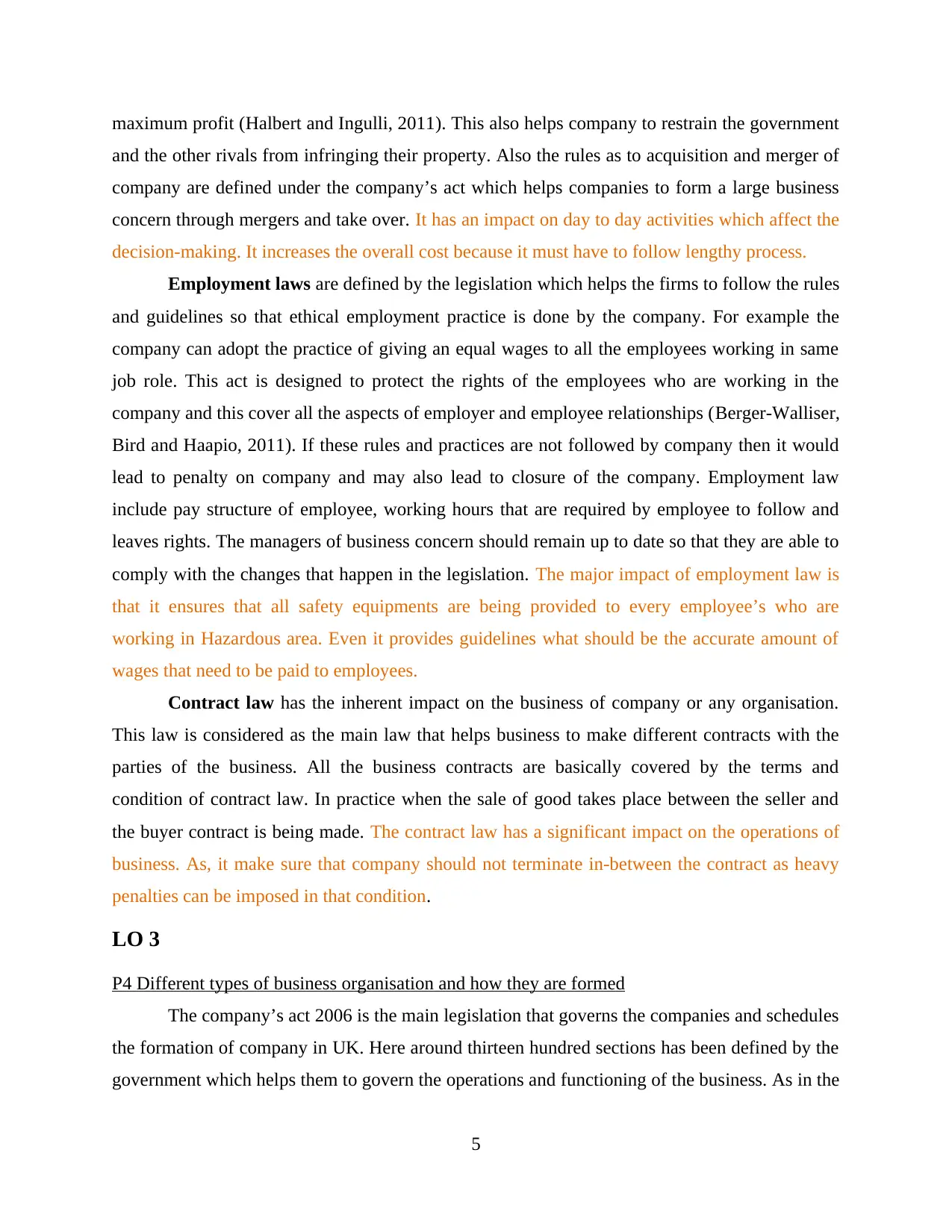
maximum profit (Halbert and Ingulli, 2011). This also helps company to restrain the government
and the other rivals from infringing their property. Also the rules as to acquisition and merger of
company are defined under the company’s act which helps companies to form a large business
concern through mergers and take over. It has an impact on day to day activities which affect the
decision-making. It increases the overall cost because it must have to follow lengthy process.
Employment laws are defined by the legislation which helps the firms to follow the rules
and guidelines so that ethical employment practice is done by the company. For example the
company can adopt the practice of giving an equal wages to all the employees working in same
job role. This act is designed to protect the rights of the employees who are working in the
company and this cover all the aspects of employer and employee relationships (Berger-Walliser,
Bird and Haapio, 2011). If these rules and practices are not followed by company then it would
lead to penalty on company and may also lead to closure of the company. Employment law
include pay structure of employee, working hours that are required by employee to follow and
leaves rights. The managers of business concern should remain up to date so that they are able to
comply with the changes that happen in the legislation. The major impact of employment law is
that it ensures that all safety equipments are being provided to every employee’s who are
working in Hazardous area. Even it provides guidelines what should be the accurate amount of
wages that need to be paid to employees.
Contract law has the inherent impact on the business of company or any organisation.
This law is considered as the main law that helps business to make different contracts with the
parties of the business. All the business contracts are basically covered by the terms and
condition of contract law. In practice when the sale of good takes place between the seller and
the buyer contract is being made. The contract law has a significant impact on the operations of
business. As, it make sure that company should not terminate in-between the contract as heavy
penalties can be imposed in that condition.
LO 3
P4 Different types of business organisation and how they are formed
The company’s act 2006 is the main legislation that governs the companies and schedules
the formation of company in UK. Here around thirteen hundred sections has been defined by the
government which helps them to govern the operations and functioning of the business. As in the
5
and the other rivals from infringing their property. Also the rules as to acquisition and merger of
company are defined under the company’s act which helps companies to form a large business
concern through mergers and take over. It has an impact on day to day activities which affect the
decision-making. It increases the overall cost because it must have to follow lengthy process.
Employment laws are defined by the legislation which helps the firms to follow the rules
and guidelines so that ethical employment practice is done by the company. For example the
company can adopt the practice of giving an equal wages to all the employees working in same
job role. This act is designed to protect the rights of the employees who are working in the
company and this cover all the aspects of employer and employee relationships (Berger-Walliser,
Bird and Haapio, 2011). If these rules and practices are not followed by company then it would
lead to penalty on company and may also lead to closure of the company. Employment law
include pay structure of employee, working hours that are required by employee to follow and
leaves rights. The managers of business concern should remain up to date so that they are able to
comply with the changes that happen in the legislation. The major impact of employment law is
that it ensures that all safety equipments are being provided to every employee’s who are
working in Hazardous area. Even it provides guidelines what should be the accurate amount of
wages that need to be paid to employees.
Contract law has the inherent impact on the business of company or any organisation.
This law is considered as the main law that helps business to make different contracts with the
parties of the business. All the business contracts are basically covered by the terms and
condition of contract law. In practice when the sale of good takes place between the seller and
the buyer contract is being made. The contract law has a significant impact on the operations of
business. As, it make sure that company should not terminate in-between the contract as heavy
penalties can be imposed in that condition.
LO 3
P4 Different types of business organisation and how they are formed
The company’s act 2006 is the main legislation that governs the companies and schedules
the formation of company in UK. Here around thirteen hundred sections has been defined by the
government which helps them to govern the operations and functioning of the business. As in the
5
Paraphrase This Document
Need a fresh take? Get an instant paraphrase of this document with our AI Paraphraser
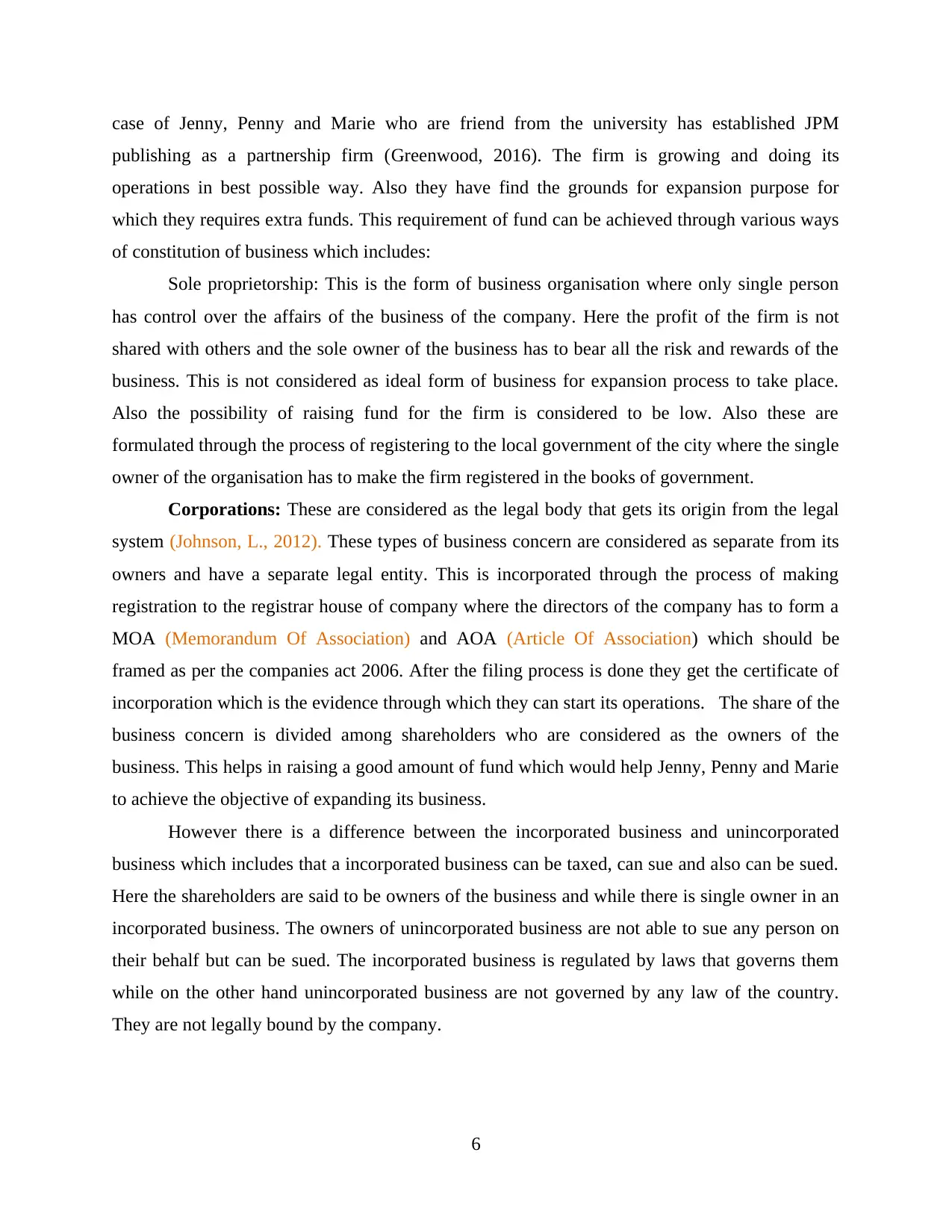
case of Jenny, Penny and Marie who are friend from the university has established JPM
publishing as a partnership firm (Greenwood, 2016). The firm is growing and doing its
operations in best possible way. Also they have find the grounds for expansion purpose for
which they requires extra funds. This requirement of fund can be achieved through various ways
of constitution of business which includes:
Sole proprietorship: This is the form of business organisation where only single person
has control over the affairs of the business of the company. Here the profit of the firm is not
shared with others and the sole owner of the business has to bear all the risk and rewards of the
business. This is not considered as ideal form of business for expansion process to take place.
Also the possibility of raising fund for the firm is considered to be low. Also these are
formulated through the process of registering to the local government of the city where the single
owner of the organisation has to make the firm registered in the books of government.
Corporations: These are considered as the legal body that gets its origin from the legal
system (Johnson, L., 2012). These types of business concern are considered as separate from its
owners and have a separate legal entity. This is incorporated through the process of making
registration to the registrar house of company where the directors of the company has to form a
MOA (Memorandum Of Association) and AOA (Article Of Association) which should be
framed as per the companies act 2006. After the filing process is done they get the certificate of
incorporation which is the evidence through which they can start its operations. The share of the
business concern is divided among shareholders who are considered as the owners of the
business. This helps in raising a good amount of fund which would help Jenny, Penny and Marie
to achieve the objective of expanding its business.
However there is a difference between the incorporated business and unincorporated
business which includes that a incorporated business can be taxed, can sue and also can be sued.
Here the shareholders are said to be owners of the business and while there is single owner in an
incorporated business. The owners of unincorporated business are not able to sue any person on
their behalf but can be sued. The incorporated business is regulated by laws that governs them
while on the other hand unincorporated business are not governed by any law of the country.
They are not legally bound by the company.
6
publishing as a partnership firm (Greenwood, 2016). The firm is growing and doing its
operations in best possible way. Also they have find the grounds for expansion purpose for
which they requires extra funds. This requirement of fund can be achieved through various ways
of constitution of business which includes:
Sole proprietorship: This is the form of business organisation where only single person
has control over the affairs of the business of the company. Here the profit of the firm is not
shared with others and the sole owner of the business has to bear all the risk and rewards of the
business. This is not considered as ideal form of business for expansion process to take place.
Also the possibility of raising fund for the firm is considered to be low. Also these are
formulated through the process of registering to the local government of the city where the single
owner of the organisation has to make the firm registered in the books of government.
Corporations: These are considered as the legal body that gets its origin from the legal
system (Johnson, L., 2012). These types of business concern are considered as separate from its
owners and have a separate legal entity. This is incorporated through the process of making
registration to the registrar house of company where the directors of the company has to form a
MOA (Memorandum Of Association) and AOA (Article Of Association) which should be
framed as per the companies act 2006. After the filing process is done they get the certificate of
incorporation which is the evidence through which they can start its operations. The share of the
business concern is divided among shareholders who are considered as the owners of the
business. This helps in raising a good amount of fund which would help Jenny, Penny and Marie
to achieve the objective of expanding its business.
However there is a difference between the incorporated business and unincorporated
business which includes that a incorporated business can be taxed, can sue and also can be sued.
Here the shareholders are said to be owners of the business and while there is single owner in an
incorporated business. The owners of unincorporated business are not able to sue any person on
their behalf but can be sued. The incorporated business is regulated by laws that governs them
while on the other hand unincorporated business are not governed by any law of the country.
They are not legally bound by the company.
6
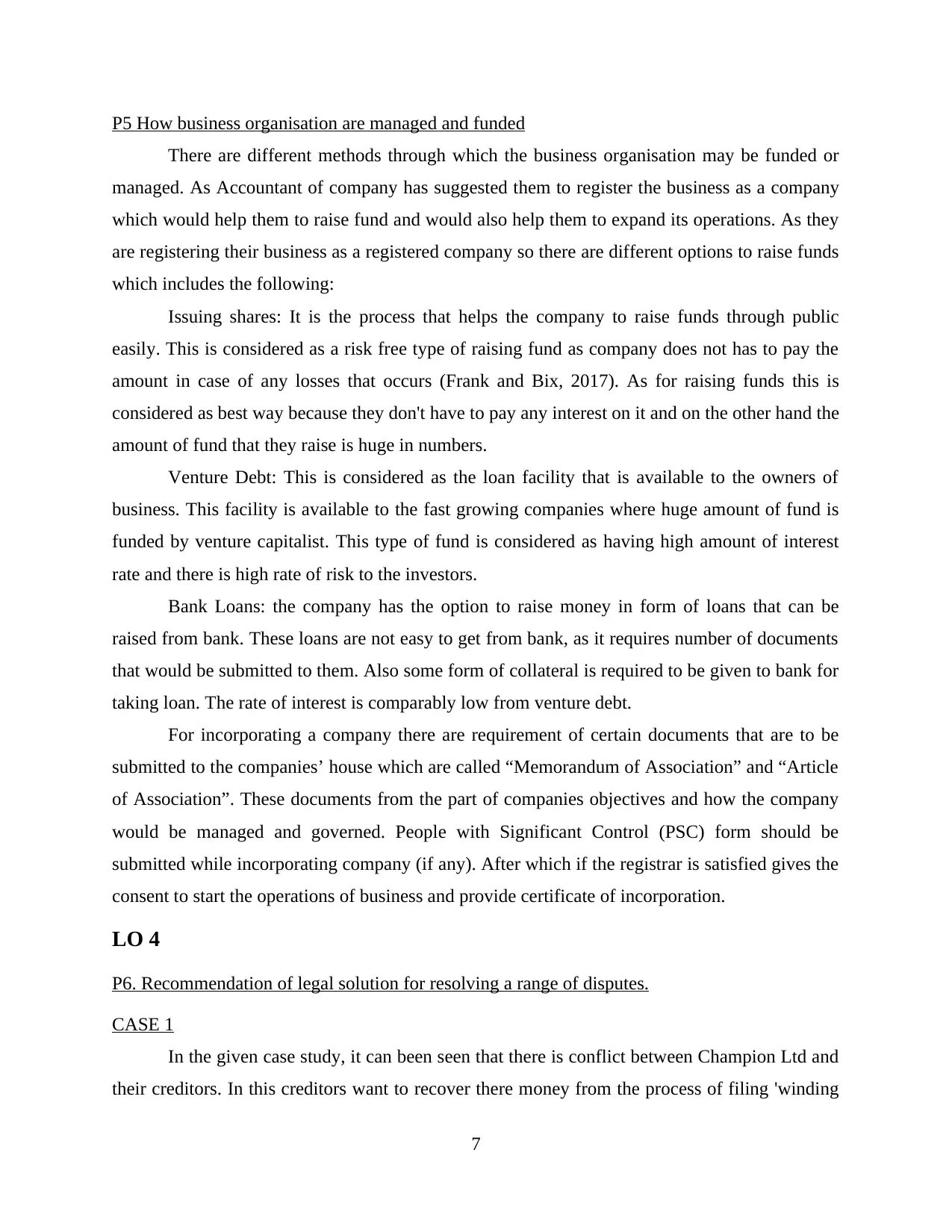
P5 How business organisation are managed and funded
There are different methods through which the business organisation may be funded or
managed. As Accountant of company has suggested them to register the business as a company
which would help them to raise fund and would also help them to expand its operations. As they
are registering their business as a registered company so there are different options to raise funds
which includes the following:
Issuing shares: It is the process that helps the company to raise funds through public
easily. This is considered as a risk free type of raising fund as company does not has to pay the
amount in case of any losses that occurs (Frank and Bix, 2017). As for raising funds this is
considered as best way because they don't have to pay any interest on it and on the other hand the
amount of fund that they raise is huge in numbers.
Venture Debt: This is considered as the loan facility that is available to the owners of
business. This facility is available to the fast growing companies where huge amount of fund is
funded by venture capitalist. This type of fund is considered as having high amount of interest
rate and there is high rate of risk to the investors.
Bank Loans: the company has the option to raise money in form of loans that can be
raised from bank. These loans are not easy to get from bank, as it requires number of documents
that would be submitted to them. Also some form of collateral is required to be given to bank for
taking loan. The rate of interest is comparably low from venture debt.
For incorporating a company there are requirement of certain documents that are to be
submitted to the companies’ house which are called “Memorandum of Association” and “Article
of Association”. These documents from the part of companies objectives and how the company
would be managed and governed. People with Significant Control (PSC) form should be
submitted while incorporating company (if any). After which if the registrar is satisfied gives the
consent to start the operations of business and provide certificate of incorporation.
LO 4
P6. Recommendation of legal solution for resolving a range of disputes.
CASE 1
In the given case study, it can been seen that there is conflict between Champion Ltd and
their creditors. In this creditors want to recover there money from the process of filing 'winding
7
There are different methods through which the business organisation may be funded or
managed. As Accountant of company has suggested them to register the business as a company
which would help them to raise fund and would also help them to expand its operations. As they
are registering their business as a registered company so there are different options to raise funds
which includes the following:
Issuing shares: It is the process that helps the company to raise funds through public
easily. This is considered as a risk free type of raising fund as company does not has to pay the
amount in case of any losses that occurs (Frank and Bix, 2017). As for raising funds this is
considered as best way because they don't have to pay any interest on it and on the other hand the
amount of fund that they raise is huge in numbers.
Venture Debt: This is considered as the loan facility that is available to the owners of
business. This facility is available to the fast growing companies where huge amount of fund is
funded by venture capitalist. This type of fund is considered as having high amount of interest
rate and there is high rate of risk to the investors.
Bank Loans: the company has the option to raise money in form of loans that can be
raised from bank. These loans are not easy to get from bank, as it requires number of documents
that would be submitted to them. Also some form of collateral is required to be given to bank for
taking loan. The rate of interest is comparably low from venture debt.
For incorporating a company there are requirement of certain documents that are to be
submitted to the companies’ house which are called “Memorandum of Association” and “Article
of Association”. These documents from the part of companies objectives and how the company
would be managed and governed. People with Significant Control (PSC) form should be
submitted while incorporating company (if any). After which if the registrar is satisfied gives the
consent to start the operations of business and provide certificate of incorporation.
LO 4
P6. Recommendation of legal solution for resolving a range of disputes.
CASE 1
In the given case study, it can been seen that there is conflict between Champion Ltd and
their creditors. In this creditors want to recover there money from the process of filing 'winding
7
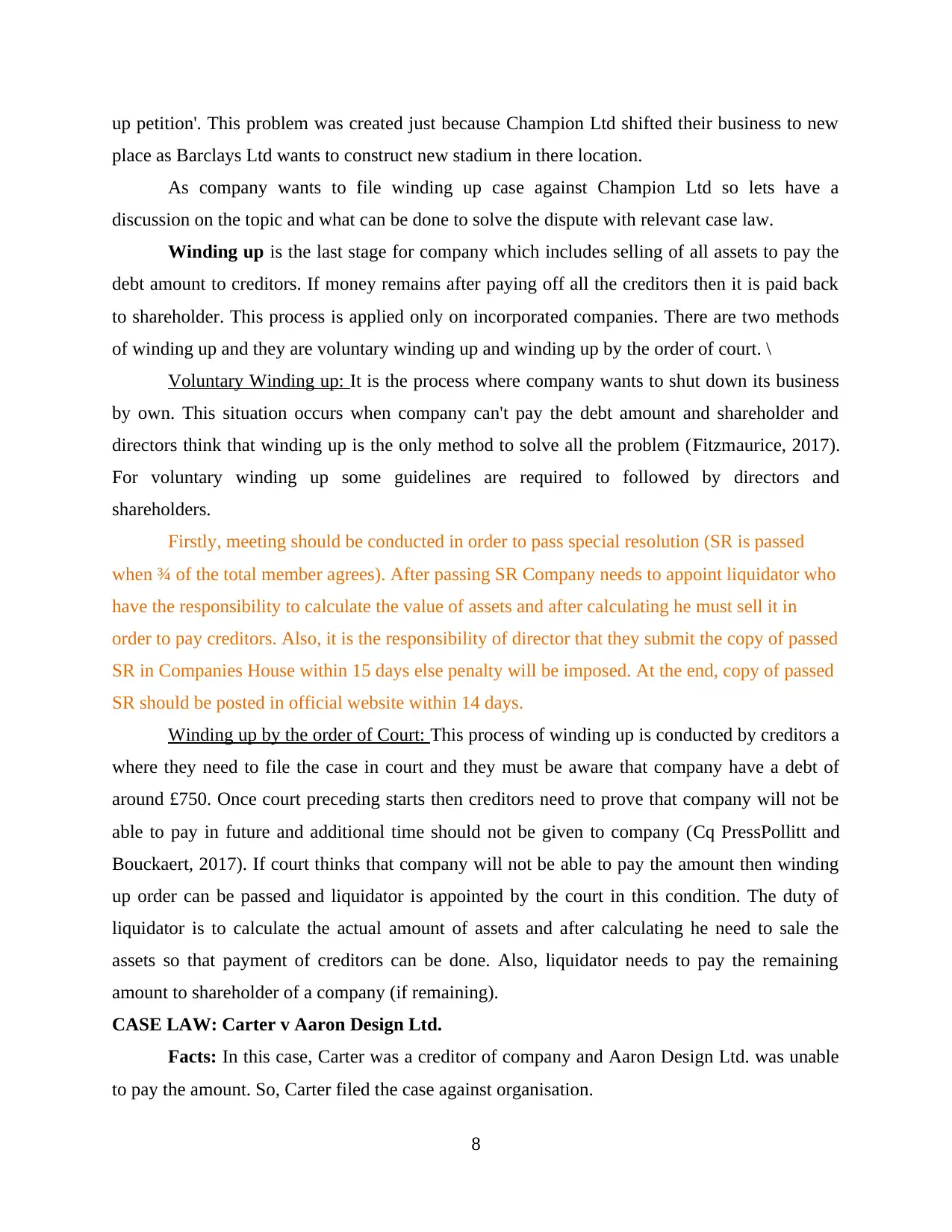
up petition'. This problem was created just because Champion Ltd shifted their business to new
place as Barclays Ltd wants to construct new stadium in there location.
As company wants to file winding up case against Champion Ltd so lets have a
discussion on the topic and what can be done to solve the dispute with relevant case law.
Winding up is the last stage for company which includes selling of all assets to pay the
debt amount to creditors. If money remains after paying off all the creditors then it is paid back
to shareholder. This process is applied only on incorporated companies. There are two methods
of winding up and they are voluntary winding up and winding up by the order of court. \
Voluntary Winding up: It is the process where company wants to shut down its business
by own. This situation occurs when company can't pay the debt amount and shareholder and
directors think that winding up is the only method to solve all the problem (Fitzmaurice, 2017).
For voluntary winding up some guidelines are required to followed by directors and
shareholders.
Firstly, meeting should be conducted in order to pass special resolution (SR is passed
when ¾ of the total member agrees). After passing SR Company needs to appoint liquidator who
have the responsibility to calculate the value of assets and after calculating he must sell it in
order to pay creditors. Also, it is the responsibility of director that they submit the copy of passed
SR in Companies House within 15 days else penalty will be imposed. At the end, copy of passed
SR should be posted in official website within 14 days.
Winding up by the order of Court: This process of winding up is conducted by creditors a
where they need to file the case in court and they must be aware that company have a debt of
around £750. Once court preceding starts then creditors need to prove that company will not be
able to pay in future and additional time should not be given to company (Cq PressPollitt and
Bouckaert, 2017). If court thinks that company will not be able to pay the amount then winding
up order can be passed and liquidator is appointed by the court in this condition. The duty of
liquidator is to calculate the actual amount of assets and after calculating he need to sale the
assets so that payment of creditors can be done. Also, liquidator needs to pay the remaining
amount to shareholder of a company (if remaining).
CASE LAW: Carter v Aaron Design Ltd.
Facts: In this case, Carter was a creditor of company and Aaron Design Ltd. was unable
to pay the amount. So, Carter filed the case against organisation.
8
place as Barclays Ltd wants to construct new stadium in there location.
As company wants to file winding up case against Champion Ltd so lets have a
discussion on the topic and what can be done to solve the dispute with relevant case law.
Winding up is the last stage for company which includes selling of all assets to pay the
debt amount to creditors. If money remains after paying off all the creditors then it is paid back
to shareholder. This process is applied only on incorporated companies. There are two methods
of winding up and they are voluntary winding up and winding up by the order of court. \
Voluntary Winding up: It is the process where company wants to shut down its business
by own. This situation occurs when company can't pay the debt amount and shareholder and
directors think that winding up is the only method to solve all the problem (Fitzmaurice, 2017).
For voluntary winding up some guidelines are required to followed by directors and
shareholders.
Firstly, meeting should be conducted in order to pass special resolution (SR is passed
when ¾ of the total member agrees). After passing SR Company needs to appoint liquidator who
have the responsibility to calculate the value of assets and after calculating he must sell it in
order to pay creditors. Also, it is the responsibility of director that they submit the copy of passed
SR in Companies House within 15 days else penalty will be imposed. At the end, copy of passed
SR should be posted in official website within 14 days.
Winding up by the order of Court: This process of winding up is conducted by creditors a
where they need to file the case in court and they must be aware that company have a debt of
around £750. Once court preceding starts then creditors need to prove that company will not be
able to pay in future and additional time should not be given to company (Cq PressPollitt and
Bouckaert, 2017). If court thinks that company will not be able to pay the amount then winding
up order can be passed and liquidator is appointed by the court in this condition. The duty of
liquidator is to calculate the actual amount of assets and after calculating he need to sale the
assets so that payment of creditors can be done. Also, liquidator needs to pay the remaining
amount to shareholder of a company (if remaining).
CASE LAW: Carter v Aaron Design Ltd.
Facts: In this case, Carter was a creditor of company and Aaron Design Ltd. was unable
to pay the amount. So, Carter filed the case against organisation.
8
Secure Best Marks with AI Grader
Need help grading? Try our AI Grader for instant feedback on your assignments.
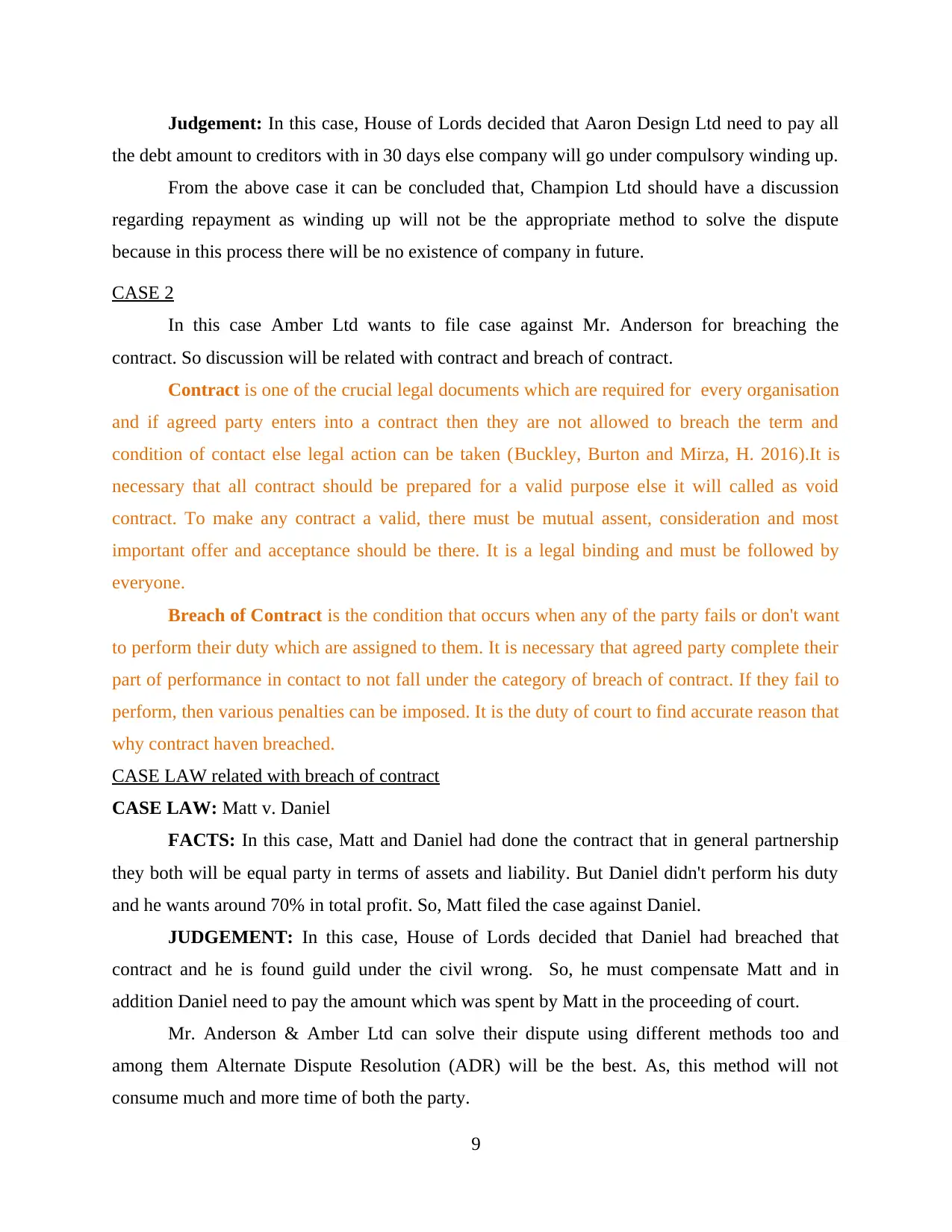
Judgement: In this case, House of Lords decided that Aaron Design Ltd need to pay all
the debt amount to creditors with in 30 days else company will go under compulsory winding up.
From the above case it can be concluded that, Champion Ltd should have a discussion
regarding repayment as winding up will not be the appropriate method to solve the dispute
because in this process there will be no existence of company in future.
CASE 2
In this case Amber Ltd wants to file case against Mr. Anderson for breaching the
contract. So discussion will be related with contract and breach of contract.
Contract is one of the crucial legal documents which are required for every organisation
and if agreed party enters into a contract then they are not allowed to breach the term and
condition of contact else legal action can be taken (Buckley, Burton and Mirza, H. 2016).It is
necessary that all contract should be prepared for a valid purpose else it will called as void
contract. To make any contract a valid, there must be mutual assent, consideration and most
important offer and acceptance should be there. It is a legal binding and must be followed by
everyone.
Breach of Contract is the condition that occurs when any of the party fails or don't want
to perform their duty which are assigned to them. It is necessary that agreed party complete their
part of performance in contact to not fall under the category of breach of contract. If they fail to
perform, then various penalties can be imposed. It is the duty of court to find accurate reason that
why contract haven breached.
CASE LAW related with breach of contract
CASE LAW: Matt v. Daniel
FACTS: In this case, Matt and Daniel had done the contract that in general partnership
they both will be equal party in terms of assets and liability. But Daniel didn't perform his duty
and he wants around 70% in total profit. So, Matt filed the case against Daniel.
JUDGEMENT: In this case, House of Lords decided that Daniel had breached that
contract and he is found guild under the civil wrong. So, he must compensate Matt and in
addition Daniel need to pay the amount which was spent by Matt in the proceeding of court.
Mr. Anderson & Amber Ltd can solve their dispute using different methods too and
among them Alternate Dispute Resolution (ADR) will be the best. As, this method will not
consume much and more time of both the party.
9
the debt amount to creditors with in 30 days else company will go under compulsory winding up.
From the above case it can be concluded that, Champion Ltd should have a discussion
regarding repayment as winding up will not be the appropriate method to solve the dispute
because in this process there will be no existence of company in future.
CASE 2
In this case Amber Ltd wants to file case against Mr. Anderson for breaching the
contract. So discussion will be related with contract and breach of contract.
Contract is one of the crucial legal documents which are required for every organisation
and if agreed party enters into a contract then they are not allowed to breach the term and
condition of contact else legal action can be taken (Buckley, Burton and Mirza, H. 2016).It is
necessary that all contract should be prepared for a valid purpose else it will called as void
contract. To make any contract a valid, there must be mutual assent, consideration and most
important offer and acceptance should be there. It is a legal binding and must be followed by
everyone.
Breach of Contract is the condition that occurs when any of the party fails or don't want
to perform their duty which are assigned to them. It is necessary that agreed party complete their
part of performance in contact to not fall under the category of breach of contract. If they fail to
perform, then various penalties can be imposed. It is the duty of court to find accurate reason that
why contract haven breached.
CASE LAW related with breach of contract
CASE LAW: Matt v. Daniel
FACTS: In this case, Matt and Daniel had done the contract that in general partnership
they both will be equal party in terms of assets and liability. But Daniel didn't perform his duty
and he wants around 70% in total profit. So, Matt filed the case against Daniel.
JUDGEMENT: In this case, House of Lords decided that Daniel had breached that
contract and he is found guild under the civil wrong. So, he must compensate Matt and in
addition Daniel need to pay the amount which was spent by Matt in the proceeding of court.
Mr. Anderson & Amber Ltd can solve their dispute using different methods too and
among them Alternate Dispute Resolution (ADR) will be the best. As, this method will not
consume much and more time of both the party.
9
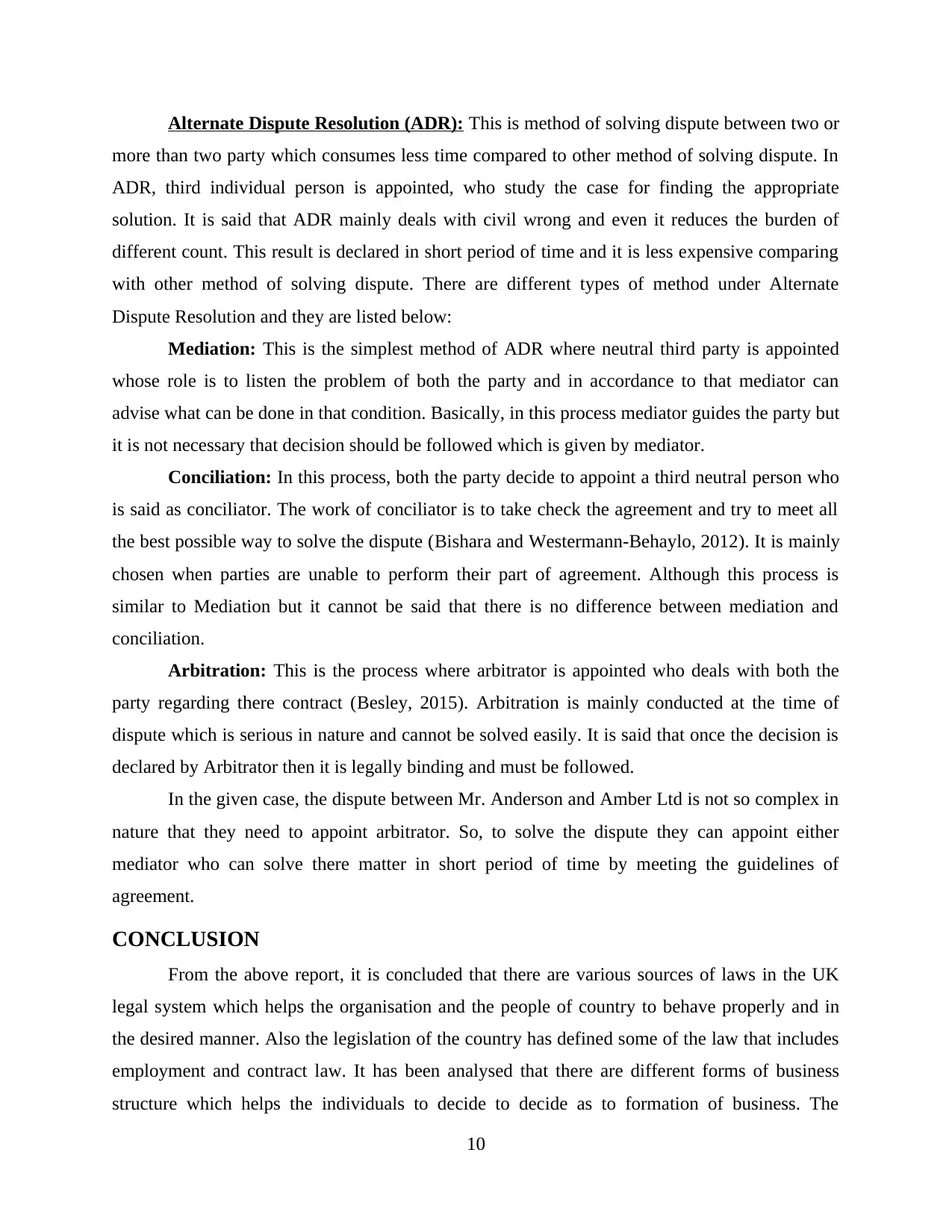
Alternate Dispute Resolution (ADR): This is method of solving dispute between two or
more than two party which consumes less time compared to other method of solving dispute. In
ADR, third individual person is appointed, who study the case for finding the appropriate
solution. It is said that ADR mainly deals with civil wrong and even it reduces the burden of
different count. This result is declared in short period of time and it is less expensive comparing
with other method of solving dispute. There are different types of method under Alternate
Dispute Resolution and they are listed below:
Mediation: This is the simplest method of ADR where neutral third party is appointed
whose role is to listen the problem of both the party and in accordance to that mediator can
advise what can be done in that condition. Basically, in this process mediator guides the party but
it is not necessary that decision should be followed which is given by mediator.
Conciliation: In this process, both the party decide to appoint a third neutral person who
is said as conciliator. The work of conciliator is to take check the agreement and try to meet all
the best possible way to solve the dispute (Bishara and Westermann‐Behaylo, 2012). It is mainly
chosen when parties are unable to perform their part of agreement. Although this process is
similar to Mediation but it cannot be said that there is no difference between mediation and
conciliation.
Arbitration: This is the process where arbitrator is appointed who deals with both the
party regarding there contract (Besley, 2015). Arbitration is mainly conducted at the time of
dispute which is serious in nature and cannot be solved easily. It is said that once the decision is
declared by Arbitrator then it is legally binding and must be followed.
In the given case, the dispute between Mr. Anderson and Amber Ltd is not so complex in
nature that they need to appoint arbitrator. So, to solve the dispute they can appoint either
mediator who can solve there matter in short period of time by meeting the guidelines of
agreement.
CONCLUSION
From the above report, it is concluded that there are various sources of laws in the UK
legal system which helps the organisation and the people of country to behave properly and in
the desired manner. Also the legislation of the country has defined some of the law that includes
employment and contract law. It has been analysed that there are different forms of business
structure which helps the individuals to decide to decide as to formation of business. The
10
more than two party which consumes less time compared to other method of solving dispute. In
ADR, third individual person is appointed, who study the case for finding the appropriate
solution. It is said that ADR mainly deals with civil wrong and even it reduces the burden of
different count. This result is declared in short period of time and it is less expensive comparing
with other method of solving dispute. There are different types of method under Alternate
Dispute Resolution and they are listed below:
Mediation: This is the simplest method of ADR where neutral third party is appointed
whose role is to listen the problem of both the party and in accordance to that mediator can
advise what can be done in that condition. Basically, in this process mediator guides the party but
it is not necessary that decision should be followed which is given by mediator.
Conciliation: In this process, both the party decide to appoint a third neutral person who
is said as conciliator. The work of conciliator is to take check the agreement and try to meet all
the best possible way to solve the dispute (Bishara and Westermann‐Behaylo, 2012). It is mainly
chosen when parties are unable to perform their part of agreement. Although this process is
similar to Mediation but it cannot be said that there is no difference between mediation and
conciliation.
Arbitration: This is the process where arbitrator is appointed who deals with both the
party regarding there contract (Besley, 2015). Arbitration is mainly conducted at the time of
dispute which is serious in nature and cannot be solved easily. It is said that once the decision is
declared by Arbitrator then it is legally binding and must be followed.
In the given case, the dispute between Mr. Anderson and Amber Ltd is not so complex in
nature that they need to appoint arbitrator. So, to solve the dispute they can appoint either
mediator who can solve there matter in short period of time by meeting the guidelines of
agreement.
CONCLUSION
From the above report, it is concluded that there are various sources of laws in the UK
legal system which helps the organisation and the people of country to behave properly and in
the desired manner. Also the legislation of the country has defined some of the law that includes
employment and contract law. It has been analysed that there are different forms of business
structure which helps the individuals to decide to decide as to formation of business. The
10
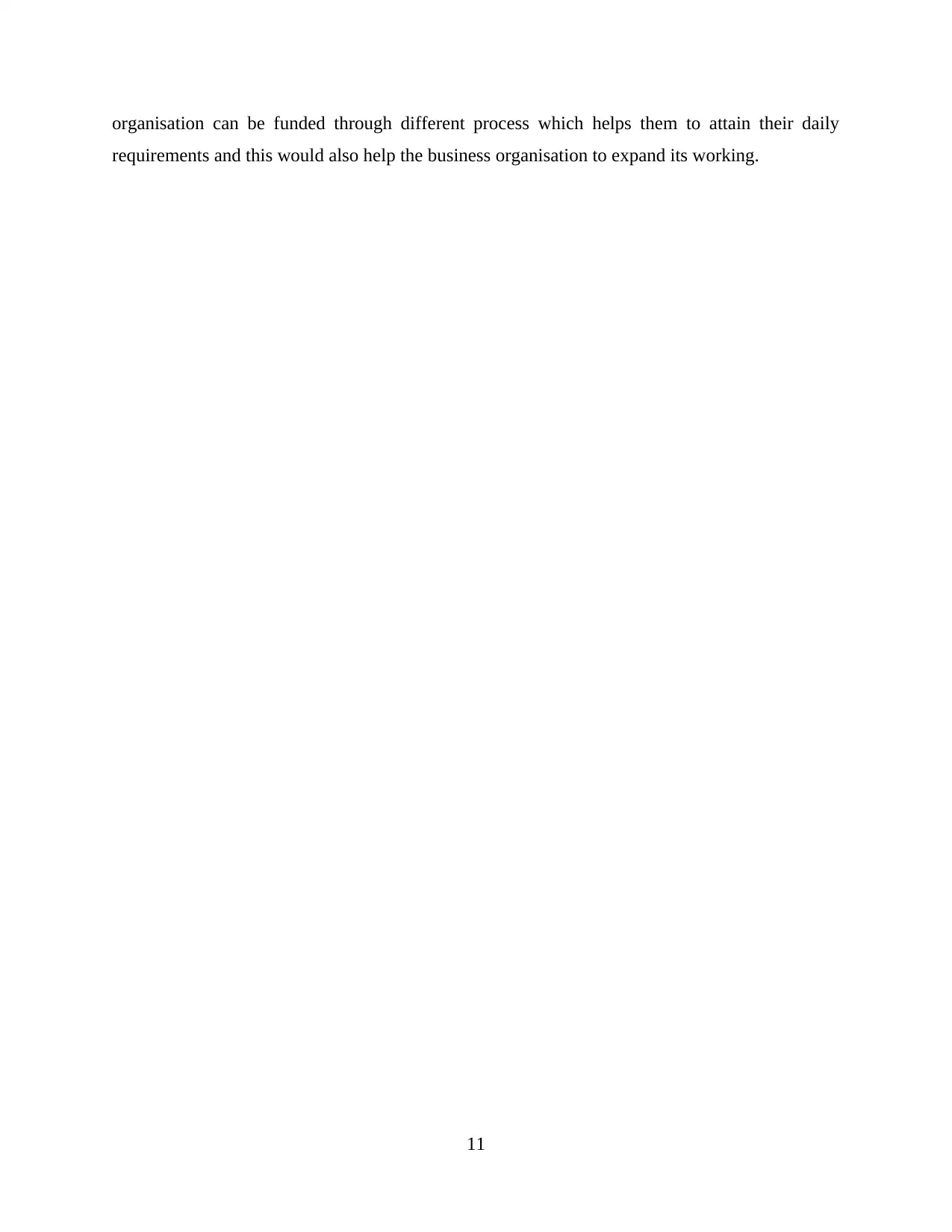
organisation can be funded through different process which helps them to attain their daily
requirements and this would also help the business organisation to expand its working.
11
requirements and this would also help the business organisation to expand its working.
11
Paraphrase This Document
Need a fresh take? Get an instant paraphrase of this document with our AI Paraphraser
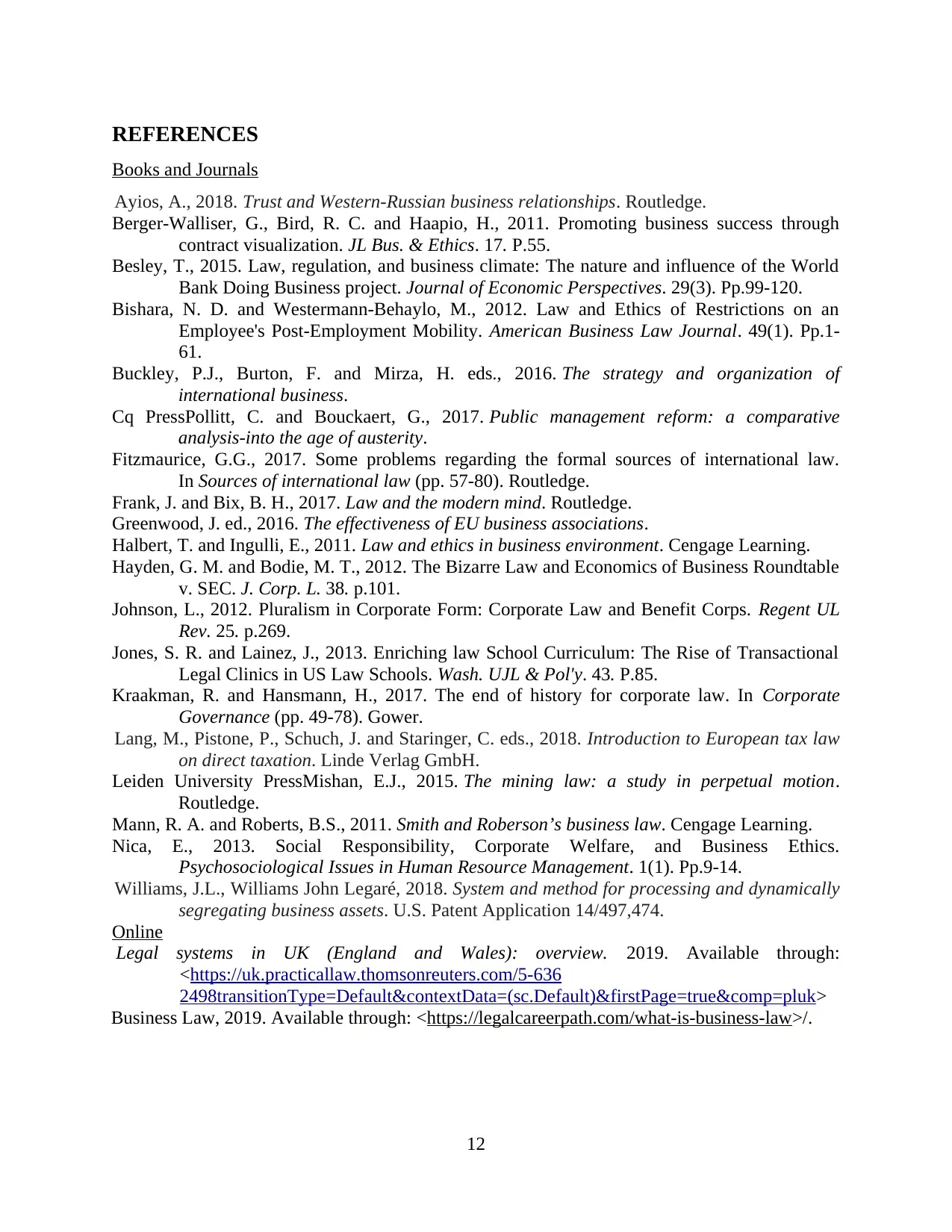
REFERENCES
Books and Journals
Ayios, A., 2018. Trust and Western-Russian business relationships. Routledge.
Berger-Walliser, G., Bird, R. C. and Haapio, H., 2011. Promoting business success through
contract visualization. JL Bus. & Ethics. 17. P.55.
Besley, T., 2015. Law, regulation, and business climate: The nature and influence of the World
Bank Doing Business project. Journal of Economic Perspectives. 29(3). Pp.99-120.
Bishara, N. D. and Westermann‐Behaylo, M., 2012. Law and Ethics of Restrictions on an
Employee's Post‐Employment Mobility. American Business Law Journal. 49(1). Pp.1-
61.
Buckley, P.J., Burton, F. and Mirza, H. eds., 2016. The strategy and organization of
international business.
Cq PressPollitt, C. and Bouckaert, G., 2017. Public management reform: a comparative
analysis-into the age of austerity.
Fitzmaurice, G.G., 2017. Some problems regarding the formal sources of international law.
In Sources of international law (pp. 57-80). Routledge.
Frank, J. and Bix, B. H., 2017. Law and the modern mind. Routledge.
Greenwood, J. ed., 2016. The effectiveness of EU business associations.
Halbert, T. and Ingulli, E., 2011. Law and ethics in business environment. Cengage Learning.
Hayden, G. M. and Bodie, M. T., 2012. The Bizarre Law and Economics of Business Roundtable
v. SEC. J. Corp. L. 38. p.101.
Johnson, L., 2012. Pluralism in Corporate Form: Corporate Law and Benefit Corps. Regent UL
Rev. 25. p.269.
Jones, S. R. and Lainez, J., 2013. Enriching law School Curriculum: The Rise of Transactional
Legal Clinics in US Law Schools. Wash. UJL & Pol'y. 43. P.85.
Kraakman, R. and Hansmann, H., 2017. The end of history for corporate law. In Corporate
Governance (pp. 49-78). Gower.
Lang, M., Pistone, P., Schuch, J. and Staringer, C. eds., 2018. Introduction to European tax law
on direct taxation. Linde Verlag GmbH.
Leiden University PressMishan, E.J., 2015. The mining law: a study in perpetual motion.
Routledge.
Mann, R. A. and Roberts, B.S., 2011. Smith and Roberson’s business law. Cengage Learning.
Nica, E., 2013. Social Responsibility, Corporate Welfare, and Business Ethics.
Psychosociological Issues in Human Resource Management. 1(1). Pp.9-14.
Williams, J.L., Williams John Legaré, 2018. System and method for processing and dynamically
segregating business assets. U.S. Patent Application 14/497,474.
Online
Legal systems in UK (England and Wales): overview. 2019. Available through:
<https://uk.practicallaw.thomsonreuters.com/5-636
2498transitionType=Default&contextData=(sc.Default)&firstPage=true&comp=pluk>
Business Law, 2019. Available through: <https://legalcareerpath.com/what-is-business-law>/.
12
Books and Journals
Ayios, A., 2018. Trust and Western-Russian business relationships. Routledge.
Berger-Walliser, G., Bird, R. C. and Haapio, H., 2011. Promoting business success through
contract visualization. JL Bus. & Ethics. 17. P.55.
Besley, T., 2015. Law, regulation, and business climate: The nature and influence of the World
Bank Doing Business project. Journal of Economic Perspectives. 29(3). Pp.99-120.
Bishara, N. D. and Westermann‐Behaylo, M., 2012. Law and Ethics of Restrictions on an
Employee's Post‐Employment Mobility. American Business Law Journal. 49(1). Pp.1-
61.
Buckley, P.J., Burton, F. and Mirza, H. eds., 2016. The strategy and organization of
international business.
Cq PressPollitt, C. and Bouckaert, G., 2017. Public management reform: a comparative
analysis-into the age of austerity.
Fitzmaurice, G.G., 2017. Some problems regarding the formal sources of international law.
In Sources of international law (pp. 57-80). Routledge.
Frank, J. and Bix, B. H., 2017. Law and the modern mind. Routledge.
Greenwood, J. ed., 2016. The effectiveness of EU business associations.
Halbert, T. and Ingulli, E., 2011. Law and ethics in business environment. Cengage Learning.
Hayden, G. M. and Bodie, M. T., 2012. The Bizarre Law and Economics of Business Roundtable
v. SEC. J. Corp. L. 38. p.101.
Johnson, L., 2012. Pluralism in Corporate Form: Corporate Law and Benefit Corps. Regent UL
Rev. 25. p.269.
Jones, S. R. and Lainez, J., 2013. Enriching law School Curriculum: The Rise of Transactional
Legal Clinics in US Law Schools. Wash. UJL & Pol'y. 43. P.85.
Kraakman, R. and Hansmann, H., 2017. The end of history for corporate law. In Corporate
Governance (pp. 49-78). Gower.
Lang, M., Pistone, P., Schuch, J. and Staringer, C. eds., 2018. Introduction to European tax law
on direct taxation. Linde Verlag GmbH.
Leiden University PressMishan, E.J., 2015. The mining law: a study in perpetual motion.
Routledge.
Mann, R. A. and Roberts, B.S., 2011. Smith and Roberson’s business law. Cengage Learning.
Nica, E., 2013. Social Responsibility, Corporate Welfare, and Business Ethics.
Psychosociological Issues in Human Resource Management. 1(1). Pp.9-14.
Williams, J.L., Williams John Legaré, 2018. System and method for processing and dynamically
segregating business assets. U.S. Patent Application 14/497,474.
Online
Legal systems in UK (England and Wales): overview. 2019. Available through:
<https://uk.practicallaw.thomsonreuters.com/5-636
2498transitionType=Default&contextData=(sc.Default)&firstPage=true&comp=pluk>
Business Law, 2019. Available through: <https://legalcareerpath.com/what-is-business-law>/.
12
1 out of 14
Related Documents
Your All-in-One AI-Powered Toolkit for Academic Success.
+13062052269
info@desklib.com
Available 24*7 on WhatsApp / Email
![[object Object]](/_next/static/media/star-bottom.7253800d.svg)
Unlock your academic potential
© 2024 | Zucol Services PVT LTD | All rights reserved.





